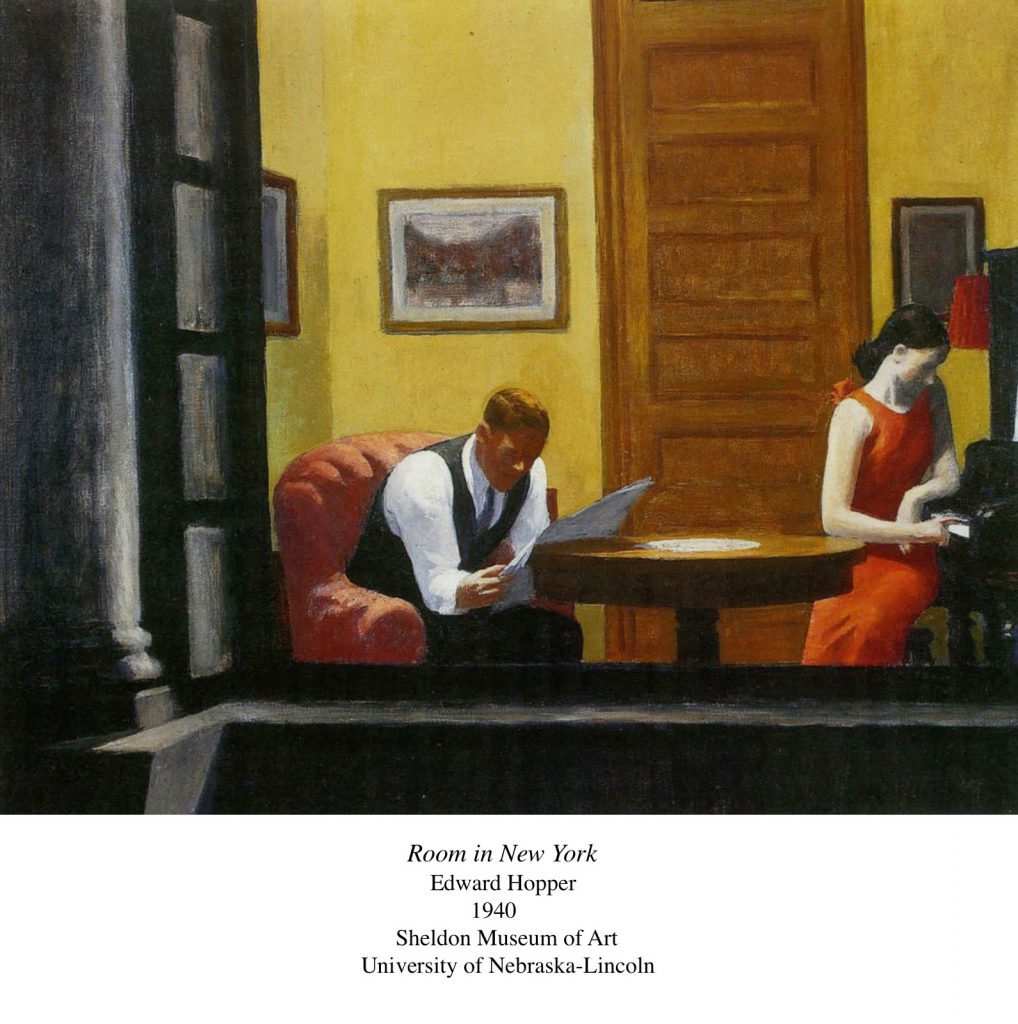I decided to become a citizen the day on which I arrived here, six years ago. I remember very well the feeling I had as the ship moved down the harbor past the Statue of Liberty and the skyscrapers. All about us were exclaiming in amazement at the strange sights, but my wife and I had the sensation of coming home.
Kurt Weill, NBC Radio interview, March 9, 1941
New York spoke to Kurt Weill. Fleeing the repression and violence of Nazi Germany, he and his wife, celebrity stage star Lotte Lenya, stepped ashore in Lower Manhattan and immediately became part of the city’s tumultuous discourse.
The conversation had begun in 1930 when Weill had seen a play in Berlin. Street Scene by Pulitzer Prize-winning dramatist Elmer Rice instantly seized the young composer’s imagination. With its blunt, straightforward dialogue and slangy cadences, the unblinking portrait of life and death on New York’s Lower East Side seemed to echo Weill’s need to convey the pulse of the modern age. The preoccupation, born of intense early collaboration with theatre activist Bertolt Brecht, had made him a box office success in Germany until fascist enforcers began intimidating his supporters. As America exhaled in the wake of World War II, partnered by Rice after fifteen years of persistent requests, Kurt Weill, joined by Harlem Renaissance poet Langston Hughes, set to work to give Street Scene forceful musical voice. On January 9, 1947 at the former Adelphi Theatre on West 54th Street, the curtain rose on the trio’s electrifying Broadway adaptation, bustling, intense, neo-operatic.
In a powerful presentation of Weill’s sharp-eyed depiction of the American dream half-dissolved by alienation and tragedy, Voicebox: Opera in Concert brought a Street Scene of gripping intimacy to Toronto’s St. Lawrence Centre, vividly sketching the work in bold, dynamic strokes. Reaching considerably beyond customary notions of semi-staged performance, a sprawling cast of intensely involved singer actors struck sparks off their volatile roles. The opportunity for both vocal and dramatic characterization is conspicuously abundant in Street Scene. Soloists and chorus amply exploited the nuances of the deeply textural score.
The son of a cantor in Dessau, schooled at an early age in classical European musical traditions, Weill knew and understood the historic conventions that had long underscored Old World opera. The antique constructs were not entirely a comfortable fit for his distinctive brand of socially acute musical theatre. Arriving in New York, he immediately put pen to staff paper, adapting his popular song-based point of view, developing a distinctly American musical vocabulary to address his new audience. What he created was no less than an artistic melting pot overflowing with familiar democratic forms. Uptown jazz, urban blues, vaudeville, gospel, swing, Broadway show tunes, advertising jingles, even snatches of children’s playsongs, all went into the mix, nineteenth century Italian opera included. It was a brave undertaking, revolutionary but still optimistic, a statement of Weill’s limitless affection for his adopted homeland, dark side and all. Street Scene would be his salute to the New World, a loving tribute and bitter critique, an American opera as he called it.
Weill’s reverence for Rice’s play, the foundation for this unique, oddly infrequently performed masterwork, is abundantly self-evident. Entire extended passages of original text are spoken, usually unaccompanied or subtly elaborated with spare orchestral chords. With the addition of Langston Hughes’ sensitive song lyrics, the story bursts to life.
A merciless heat wave grips New York. The residents of a ramshackle tenement block on the Lower East Side gather outdoors at the end of a long oppressive day. Busybodies Emma Jones and Greta Fiorentino, gossipy Olga Olsen, veteran grumbler Abraham Kaplan, everyone, it seems, has heard the latest rumour. Anna Maurrant, the woman upstairs, is seeing Mr. Sankey, the milk money collector. Better hope her husband Frank never finds out. Mr. Sankey is married, too. Moments later, studious Sam Kaplan turns up, shyly inquiring after Frank and Anna’s daughter, Rose. Mrs. Maurrant, who has just come down for a breath of air herself, informs him that she is working late. Sam heads for the local library, his arms piled with books. Frank Maurrant arrives home, bad-tempered and brooding as usual. No sooner has he left to wash up when Mr. Sankey conveniently stops by on his rounds. Anna slips away to look for her son, Willie. Or so she claims. No one believes her feeble excuse. Lippo Fiorentino strolls into sight, clutching handfuls of ice cream cones, a welcome treat for his neighbours on a sweltering evening. The fleeting light-hearted mood is shattered by Anna and Sankey’s return, the tension made more ominous by Frank’s reappearance. Sam returns with young Willie in tow. He has rescued him from a fistfight with a gang of bullies down the street. Threatening to make trouble if Rose is not home before him, Frank heads for the nearest bar. The others head for bed. Sam pauses to reflect on his loneliness then makes his exit, too.
Rose enters with her boss, lecherous real estate salesman Harry Easter. Sweet talk and glossy promises to make her a Broadway star fail to seduce her. Harry slinks off. Frank staggers into the scene, back from a bout of heavy drinking. Tortured by feelings of powerlessness, raging and obsessed, he makes his way indoors. Rose follows. The night wears on. A pair of giddy lovers flirts and dances on the moonlit sidewalk. In a sweaty walk-up overlooking the street, the birth of the young Buchanan’s first child causes huge excitement. Sam and Rose finally share a quiet moment together. And a tender kiss.
Morning dawns. Another steamy day. Anna, who has been caring for Mrs. Buchanan all night, leaves to go to the nearby grocery store. Frank appears, more suspicious and hostile than ever. Rose pleads with him to treat her mother more kindly. Anna returns. Frank accuses her of having an affair. Anna bitterly denies it. Rose defends her. The three argue. Violence crackles in the thick, sticky air. Frank storms off in a rage, bound for New Haven on business. Willie leaves for school. Anna heads indoors. Sam and Rose briefly reunite. Rose confesses that she is more tempted by Harry Easter’s offer than she had led her boss to believe. Sam is deeply upset and begs her to run away with him. It is an appealing idea to Anna at first, but she, like Sam, sees it for what it is — a beautiful, impossible fantasy. Events quickly turn sinister. Anna re-encounters Mr. Sankey, hurrying him upstairs where she can speak to him in private. Suddenly, Frank is back. Business can wait. His wife needs talking to. Glancing up, he sees the shades drawn in his family’s apartment. Sam hurls himself in his path. Frank rips him aside and explodes into the building. Shots ring out. Anna and Mr. Sankey are murdered. Frank is arrested. Lives are destroyed. Rose decides she must leave New York, taking Willie with her. Flight is their only future. Perhaps sometime, somewhere she and Sam will meet again but both know in their hearts that day will never come.
Weill spent many weeks during Street Scene’s lengthy 2-year conception walking the Lower East Side, absorbing the sounds of the hard-scrabble immigrant neighbourhood. Like Leonard Bernstein’s West Side Story that would premiere a decade later and draw on Street Scene’s strengths, New York is every bit as much of a distinctive character in Elmer Rice’s geocentric drama as Mr. Fiorentino, Mrs. Olsen or Abraham Kaplan. But this is so much more than a day-in-the-life snapshot of a city where viciousness and violence dwell next door to dreams.
Devoid of set, drawing on minimal props and costuming, Dramatic Advisor Guillermo Silva-Marin together with his remarkably inventive cast essentially reframed the story, cropping the picture from macro to micro, focusing on Street Scene’s fiercely human dimension. Betrayal, love, hurt, jealousy, these are emotions that transcend place and time. All were revealed.
Appearing as Sam Kaplan, tenor Colin Ainsworth brought a powerful, supremely appealing blend of strength and vulnerability, physicality and reserve to the intricate character. Ainsworth’s instrument is seriously robust with an enormous reach but there is a delicacy, a fine-tooled exquisiteness much in evidence here, too. The delivery is impressive. Lonely House, arguably the ultimate expression of Weill’s Broadway style, a heady cocktail of jazz and blues, was sung with heartrending poignancy by this fine Canadian artist.
Jennifer Taverner brought enormous dignity and poise to her Rose, her lovely, warm soprano both soaring and centred. Weill gifts his heroine with a classic forties big band ballad, What Good Would the Moon Be?, sung by Taverner to great effect, smooth as satin, shiny as starlight. Glenn Miller would have approved.
As the darkly dangerous Frank Maurrant, Diego Catalá terrified in a chilling performance, as savage as it was understated. Stillness has rarely seemed more unnerving. Catalá’s snarl was spine-chilling.
In the role of Anna Maurrant, soprano Monica Whicher sang with strong, unclouded purpose, her voice a sheet of sadness and despair. Her shattering rendition of Weill’s plaintive Act I showpiece, Somehow I Never Could Believe, immediately set the tone for what was to come, vividly capturing the aria’s striking, modernized Puccinian colours. Pure, uncomplicated and direct, Whicher gave brave voice to her Anna, a woman starved for affection, scorned and brutally stigmatized.
Leigh-Ann Allen and Michelle Garlough were scandalmongers Greta Fiorentino and Emma Jones, opening the production with a sizzling, bluesy, Ain’t It Awful, the Heat? Baritone Gregory Finney was a model Mr. Kaplan, the caustic, grouchy, hell-raising old Marxist. Fabián Arciniegas as Mr. Fiorentino led a boisterous ensemble in a delightfully rambunctious Ice Cream Sextet, Weill’s tongue-in-cheek salute to the glory of opera buffa. Julia Henderson voiced an endearingly sweet Jennie Hildebrand. Janaka Welihinda was a sly Harry Easter. Keenan Viau as Dick McGann and Tamara Newberry as Mae Jones sang and danced Street Scene’s irresistible jitterbug showstopper, Moon-Faced, Starry-Eyed, tearing up the stage with their infectious energy and high spirits.
A supple, polished 15-player chamber orchestra under the direction of Conductor Robert Cooper wove an intricate tapestry of sound, delivering the full sweep of Weill’s startling, polychromatic music with unfailing virtuosity and zest. The Voicebox Chorus provided added mass and harmony, superbly operatic in its articulation of distinctive, individualized voices.
Winner of the first Tony Award for Best Original Score, Street Scene played for a respectable 148 performances on Broadway, by no means a flop but hardly a smash hit. Critics were wildly enthusiastic and continue to be to this day, producers less so. Thankfully, the work endures, although sadly still in the background of twentieth century repertoire. Opera in Concert has fearlessly brought it forward, shining a spotlight on Weill’s ground-breaking piece. This Street Scene positively glowed.


